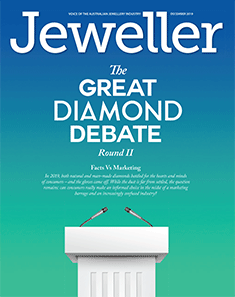 Key points Key points
• The World Federation of Diamond Bourses allows member bourses to set their own synthetic diamond trading policy • Synthetic diamond manufacturers must be held to the same strict standards as diamond mining companies • Consumers should be fully informed about the attributes of each product, including environmental impact and resale value |
At the outset, let me stress that the WFDB allows each bourse to make its own decision regarding trading in synthetics on their premises. For example, the Bharat Diamond Bourse in Mumbai does not allow trading in such stones.
Meanwhile, the Federation of Belgian Diamond Bourses has banned trading of lab-growns in any of the trading halls of its four exchanges, although it will still be permitted in private companies’ offices; the same rule applies at the Israel Diamond Exchange.
Earlier this year, a tender of rough synthetics took place at the Dubai Diamond Exchange.
I must also stress that the WFDB has no issue with synthetics, just as long as they are fully disclosed. They are clearly a separate niche market, and whoever wants to buy such stones is, of course, free to do so.
Would I recommend proposing to a partner with a synthetic stone? Frankly, I would not, but we are all free to do what we believe is right.
Environmental claims
However, I believe that consumers must be fully informed on which type of stone they are spending their money when they buy such a product.
They must know that they are purchasing stones that are mass-produced in factories and made in a month or two using large amounts of electricity in order to create heat and pressure for the production process.
Since most synthetic stones are made in China and India, where more than 80 per cent of electricity is generated by burning coal, their carbon footprint is, necessarily, high.
This is, therefore, at odds with the claims of synthetics manufacturers who have described their products as being ‘eco-friendly’ in order to appeal, in particular, to Millennial consumers. It is only right that this should not go unchallenged.
This is also in the interest of the synthetic diamond manufacturers themselves, who face being ‘caught out’ by consumers searching for detailed information about the manner in which the stone they bought was made.
The WFDB is in favour of complete transparency regarding diamond mining and this must also be the standard of the synthetics manufacturers, regarding production processes.
We accept that diamond mining also has an environmental impact and miners must use more renewable energy sources and reduce their carbon emissions.
In this respect, I would point to the efforts of De Beers, which is investing in technology to store carbon in the rocks at mines, and aiming to create its first carbon-neutral pit.
Clearly, this is still some way from happening, but the very fact that it is taking place shows the concern of diamond miners for the environment and climate change. And with De Beers leading the way, it is likely that other companies will follow suit.
Cost and value
Another important point that buyers of synthetics should bear in mind is that the production cost of these stones is declining continuously. What this means, in practice, is that they have little inherent value on the day they are bought and practically no resale value.
Let us compare that with diamonds from the Earth, which are billions of years old and have proved for thousands of years that they retain their value – and, indeed, can increase with time.
This is the reason that they are handed down from generation to generation: not simply because of their sentimental value, but because of their financial value as well.
I believe it would be fair and accurate to say that this is unlikely to happen with a synthetic diamond.
And, finally, I would point out that it is important to keep in perspective the impact of synthetics.
Although the media coverage has been high, synthetic stones are still a very small part of annual global polished supply: around 2–4 per cent of the approximate $US19 billion in polished sales per year.
As I mentioned above, it is incumbent on both the diamond industry and the synthetic manufacturers to be completely transparent and honest in marketing and selling.
This is most certainly the approach that we are taking, and we hope that the synthetic diamond companies will do likewise.
View & Download eMag
To download PDF version click here.
 | OUT NOW!
The Great Diamond Debate Part II
READ IT ALL IN JEWELLER'S FEATURE SPECIAL
Did you need full access to read all the stories?
From only 26c a day you can access 10 years' worth of
content in Jeweller's Business Library. Click here to subscribe » |